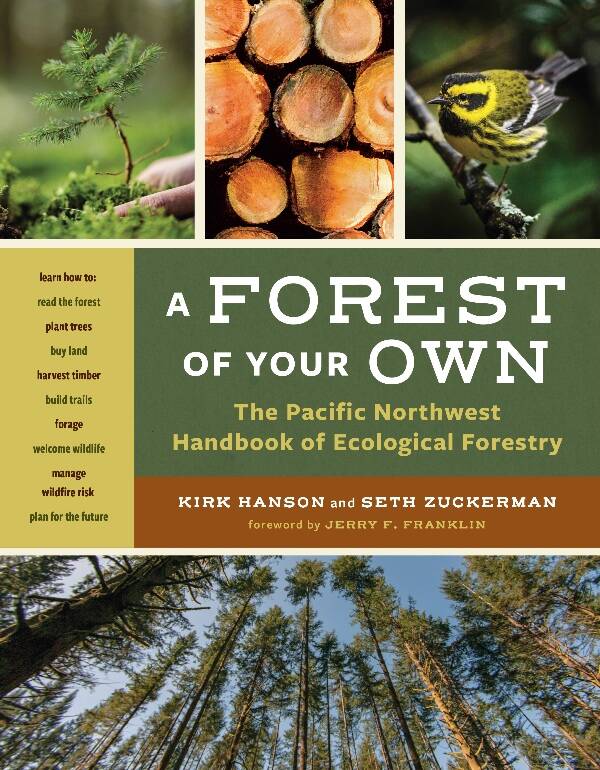In the new book, “A Forest of Your Own: The Pacific Northwest Handbook of Ecological Forestry,” islander Seth Zuckerman and co-author Kirk Hanson lay out a comprehensive and practical guide for current and would-be Pacific Northwest forest stewards — a book that aims to help readers truly see the forests for the trees.
Zuckerman, a journalist and author who has reported extensively on forests, salmon, and the human communities that depend on them, and the executive director of the nonprofit, forest-ecology focused Northwest Natural Resource Group (NNRG), will give a free presentation on the book at 6 p.m. Tuesday, April 23, at the Vashon Library.
It’s a talk about a book he hopes will inspire islanders — citizens of what Zuckerman calls the “forest nation” of the Pacific Northwest, for whom the book was written.
In an interview, Zuckerman said the aim of the book is to provide a “how-to” guide to ecological forestry — a topic he and Hanson, who serves as the director of forestry for NNRG, want to make more accessible to all.
“The central idea for us was to create a book that might do for forestry what John Jeavons’ “How to Grow More Vegetables” did for organic gardening 40 years ago — to get people excited about it, and to give them pointers about how to do it,” he said.
On Vashon, he pointed out, many have backyard forests, with two to 10 acre parcels of forestland located on their property. For other islanders, Island Center Forest, Shinglemill Creek or Dockton Forest might be the place they consider to be a “forest of their own,” he said.
His book, he hopes, will help readers better understand these towering, sun-dappled places and then take step-by-step actions to keep woodlands healthy, productive and teeming with life.
“You could read some of the chapters in this book and never look at your favorite trail in Island Center Forest in the same way again,” he said.
The book, published on April 1 by the Skipstone imprint of Seattle’s independent and nonprofit Mountaineers Books, has received high praise.
Calling it “brilliant, eloquent, and authoritative,” Denis Hayes, co-founder of Earth Day and president of the The Bullitt Foundation, defined the guide “the only book you’ll ever need to understand sustainable forestry in the Northwest.”
“A Forest of Your Own” is decidedly a “how-to” guide to ecological forestry — sharing expertise on topics including how to “read” a forest, sustainable management, wildfire risk reduction, climate change adaptation, ways to enhance wildlife habitat, watershed protection, and much more.
Packed with informative tables, instructive illustrations, and inspiring real-life examples, the book is also a buyer’s guide for those considering purchasing both large and small tracts of forestland — and an owner’s manual for anyone whose property already includes woodlands. Sections on both planting and harvesting trees, building trails, and foraging are also found on its 288 pages, which are adorned with almost 100 color photos.
And while the book is designed to be used as a well-thumbed practical resource, it doesn’t skimp on passages that provide the “why-to” behind the “how-to.”
Forests, Zuckerman writes, are a bulwark against climate change, storing vast amounts of carbon and keeping it out of the atmosphere where it would contribute to global warming. They also play an invaluable role in providing clean, reliable water: the watersheds for Seattle, Tacoma, Bellingham and Portland are all covered in well-managed forests, which protect the quality of water for all those who live in those cities, he points out.
They are also places of abundant life, sheltering countless species of wild creatures both great and small — mammals of every size and stripe, birds, amphibians, insects, mollusks and fish — and offer up a garden of earthly delights from edible fungi to maple syrup to succulent berries.
But in addition to all these benefits, forests have always — since the first time humans joined the other beasts and bugs and birds and creatures in experiencing them — offered something else, Zuckerman writes.
Finding “connection with the land and forest that cloaks it,” is something that uplifts the human spirit and puts our own lifespans in perspective, Zuckerman believes — and that should be protected for future generations.
“There are certain experiences that remind us humans that we occupy a minor divot in the space-time continuum,” he writes in the book. “Looking up at the Milky Way on a dark night, we can see how tiny we are in the vast cosmos. Walking through a grove whose trees predate Benjamin Franklin, Queen Elizabeth I, or the Magna Carta, we can see ourselves as a similarly minor, temporary presence from the perspective of the western conifer. With this outlook, planning for your woodland beyond your lifetime can seem like an essential duty.”
“A Forest of Your Own” is available for sale at Vashon Bookshop and other booksellers, and will be available at the Vashon Library event on April 23. To find out more, visit nnrg.org/book.



